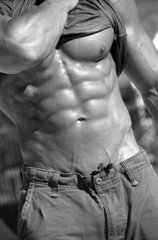Some experts believe that low blood sugar plays a big role in PMS. During the premenstrual phase, glucose, or blood sugar, levels may drop. The brain needs glucose to function properly. Low glucose can cause headaches, depression, and confusion.
Yet another theory contends that poor nutrition leads to, or exacerbates, PMS. Some doctors think that women with PMS don't get enough calcium, magnesium, or vitamins E or B6. Foods often flagged as PMS triggers are white sugar and flour, caffeine, alcohol, and fatty foods.
Consider these tips for trying to ease your PMS symptoms by analyzing when and what you eat:
* Eat often. During PMS, many women have low blood sugar. When blood sugar drops, cortisol is released, which may make you nervous, jittery, and anxious. As blood sugar plummets, you find yourself craving cookies, chips, and just about anything fried in grease.To avoid this roller coaster, eat at least every four hours. Most doctors recommend eating three small meals and two to three snacks a day.
* Choose slow-burning foods. So what should you eat every four hours? Pick foods that your body processes slowly. Lean protein, such as chicken, turkey, soy foods, and fish, and above-the-ground vegetables, such as broccoli, cauliflower, and peppers, are all good choices. Try not to eat foods that can raise blood sugar quickly, such as white flour and sugar, potatoes and carrots.
Whole grains also are a healthy choice. A good rule is to look for brown foods at the grocery or health food store, such as brown rice, oatmeal, and whole wheat.
* Skip the salt. Hiding the salt shaker can also help control PMS. Dr. Goldstein puts all of his PMS patients on low-salt diets. Salt encourages your body to retain water. The fluid retention can cause bloating all over your body. Water retained in the brain can cause headaches, and extra water in the breasts can make them tender.
* Kick caffeine and alcohol. What you drink can make your PMS better or worse too. "Beverages can be an Achilles' heel for women with PMS," says Dr. Susan Lark, a specialist in preventive medicine and clinical nutrition. Soft drinks are packed with sugar. Alcohol is processed into sugar by your body, and it also depresses your nervous system, which affects mood. Women who drink alcohol often complain of anger as a PMS symptom.
The caffeine in your morning coffee or afternoon soda can cause breast tenderness, mood swings, and anxiety. A study of more than 200 college women found that 60 percent of those who drank more than 4-1/2 cups of caffeinated beverages a day had severe PMS symptoms.
* Turn on the tap. Instead of coffee or soda, guzzle water. Some women fear that drinking more water will add to bloating, but adding water helps your body eliminate bothersome fluids. When you're dehydrated, your body hangs onto water, making bloating worse.
* Consider supplements. In addition to the right food and drink, some vitamins, minerals, and supplements have given women relief. A 1998 study of more than 400 women in the American Journal of Obstetrics and Gynecology found that 1,200 milligrams of calcium supplement each day cut PMS symptoms almost in half after three months. The B complex vitamins, which are involved in more biochemical reactions in the body than any other vitamin, seem to improve mood and reduce bloating.
To help soothe nerves, some women take magnesium. Evening primrose oil and other essential fatty acids, such as borage or flaxseed oil, are sometimes recommended by doctors to reduce cramping and relieve breast tenderness. All are sold at most health food stores.
Work Out to Feel Better
Doctors don't know for sure why exercise helps PMS, but some believe that it helps stabilize blood sugar. Getting active may also increase endorphins, the body's relaxing hormones that are 500 times more potent than morphine. A brisk 20- or 30-minute walk three times a week seems to be enough to help most women.
Exercise is one of the first things that the staff at PMS Access in Madison, Wisconsin, recommends to the more than 2,000 women who call every day with questions on how to relieve PMS naturally. Cofounder Marla Ahlgrimm, a registered pharmacist, says exercising helps women elevate their mood and ease anxiety.
Run a hot bath and soak for 20 minutes, walk the dog around the block without the kids, or check out that yoga class at the gym. For most women, 15 to 20 minutes by themselves is enough time to clear their heads.
PMS or Perimenopause?
Many women notice that their PMS gets worse with age. Although experts aren't sure why this is, some believe that it's related to the hormonal changes that happen prior to menopause. As the body prepares to shut down reproduction, it produces less and less estrogen and progesterone.
The average age of menopause is between 49 and 54, but women can be in perimenopause for as many as 10 years before menopause. "Menopause is really ovarian retirement," explains Dr. Christine Green, a family physician in Palo Alto, California. "But the ovaries don't quit all at once, they just go on vacation."
But vacationing ovaries can mean irregular periods, anxiety, insomnia, weight gain, and mood swings. Sometimes it's difficult to distinguish perimenopause from PMS. Because both conditions are treated symptomatically, it's not imperative to decide which you have. In fact, you may have both. "When I see perimenopausal PMS, I call it PMS," says Dr. Green.
Changes in diet and exercise seem to help both perimenopausal and PMS symptoms. However, in perimenopausal women, emotional symptoms might not respond as readily to natural remedies. Antidepressants or other drugs might be needed to help you feel better.
Beyond Self-Help
If diet and exercise don't do the trick, it may be time to try something else. Your doctor might suggest a low-dose birth control pill. Some doctors believe that an imbalance of the sex hormones estrogen and progesterone causes PMS. Too much estrogen can make you anxious, irritable, and confused. Too much progesterone, a natural relaxant, can lead to depression. The pill can regulate your menstrual cycle and keep your hormone levels steady throughout the month.
Or ask your doctor about natural progesterone, which is sold over the counter. Its use in treating PMS is somewhat controversial, but some women swear by it. Clinical study results have varied, with some finding progesterone effective and others concluding that it had no effect on symptoms at all. Women who have taken natural progesterone report that it has a calming effect.
However you treat your PMS, remember you're not alone. Finding a person who believes that what's going on with you is real will help you feel more in control.

 I like being straight with people whether they like it or not. So to be straight with you: the 3 biggest issues in getting your abs in top condition are as always--
I like being straight with people whether they like it or not. So to be straight with you: the 3 biggest issues in getting your abs in top condition are as always--




















